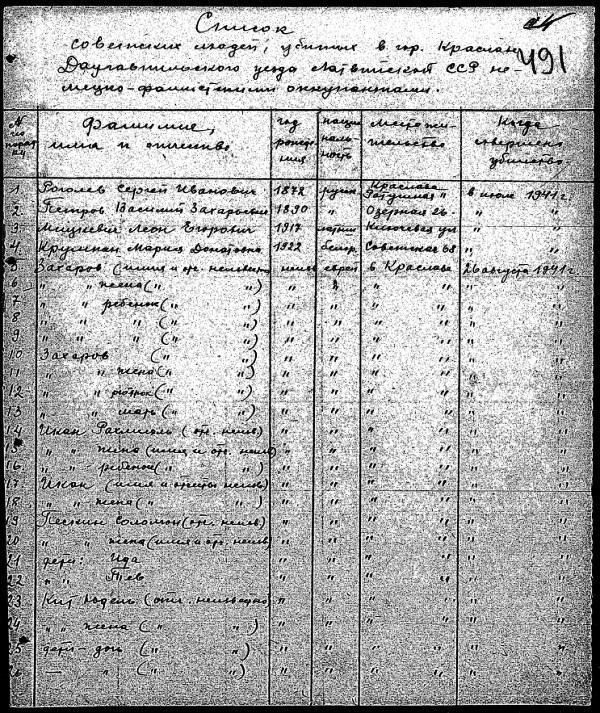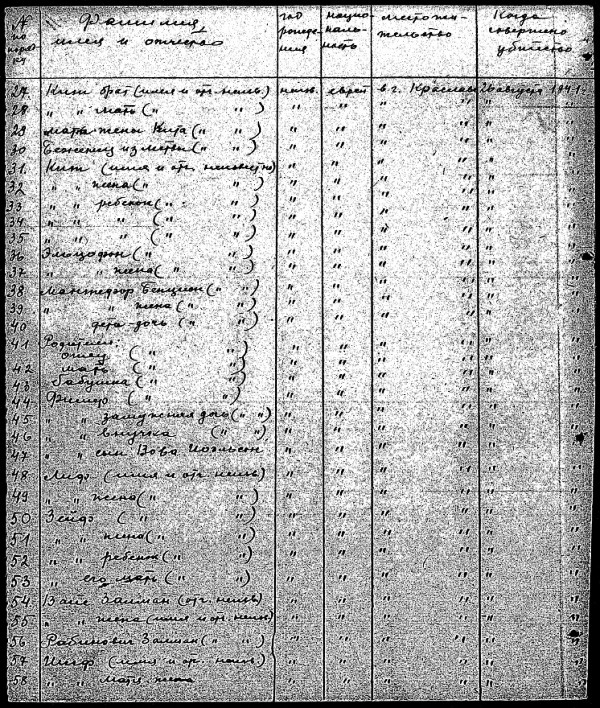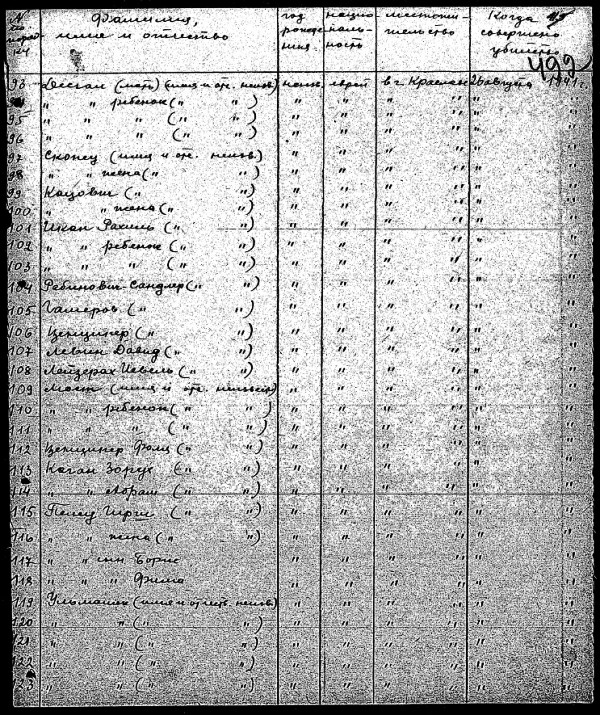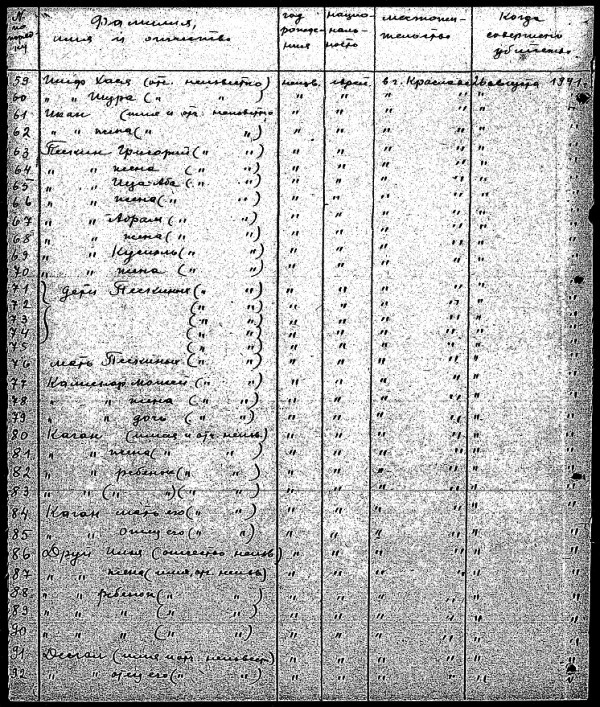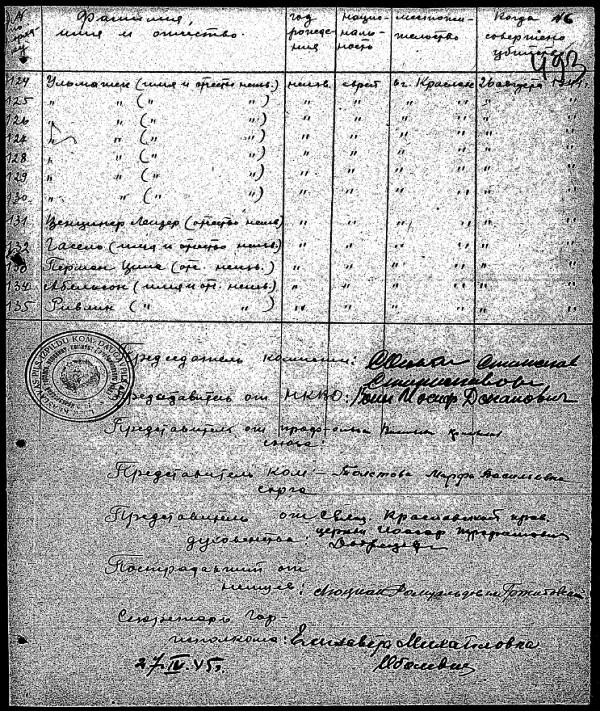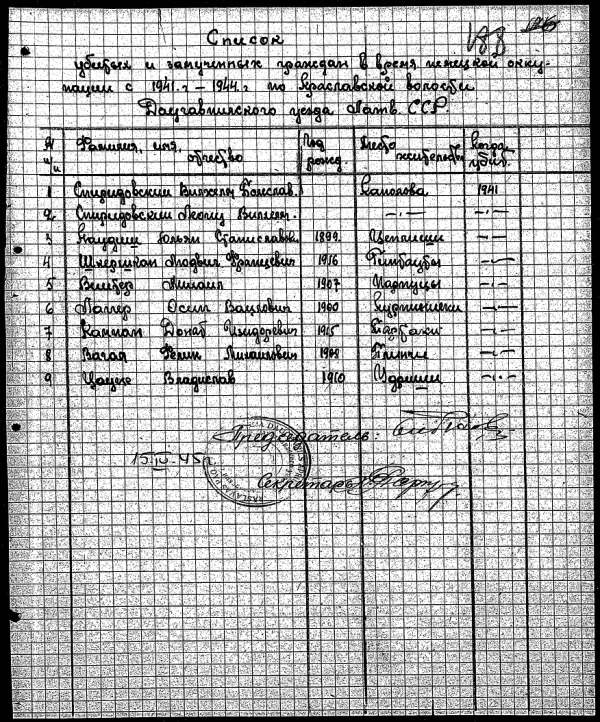
ESC - War Crimes
55°54'N, 27°10'E


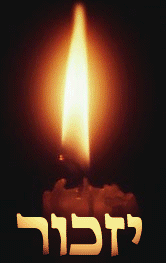
Extraordinary State Commission to Investigate and Establish War Crimes of the German-Fascist Invaders
The “Extraordinary State Commission to Investigate and Establish War Crimes of the German-Fascist Invaders” was set up by decree of the Presidium of the Supreme Soviet of the U.S.S.R. on 2nd November 1942, to investigate and document the atrocities that occurred during the German occupation of the Soviet Union. The Extraordinary State Commission (ESC) compiled testimonial information gathered from the evidence of neighbours, eyewitnesses, and survivors. Republican, regional and district municipal commissions were created to assist in the work of the ESC, regional commissions contributed their reports to a centralised commission in Moscow. Both the central office, as well as the local offices of the ESC, were composed of statesmen (Communist Party members) and representatives of public research and cultural organisations, as well as of religious denominations. Their duty was to collect and verify data, and draw up protocols on the atrocities of the German invaders and on the damage caused to the Soviet Union and its citizens. In this process a total of 54,784 such protocols were produced, of which a small number were submitted by the Soviet prosecutors in evidence for War Crimes and Crimes Against Humanity at Nuremburg at the end of World War II.
After the war these protocols were deposited in the Central State Archive of the October Revolution in Moscow (Tsentral'nyi Gosudarstvennyi Arkhiv Oktiabr'skoi Revoliutsii), which is now called the State Archive of the Russian Federation (Gosudarstvennyi Arkhiv Rossiiskoi Federatsii) or GARF.
Copies of the protocols were presented to Yad Vashem after the dismantling of the USSR. They are available on line, still in their original Russian form, though many of the names have recently been added to Yad Vashem's list of victims often with spellings that make clear identification complex.
The records are of both genealogical and historical interest because they contain numerous lists of Jewish victims as well as testimonies of witnesses and townspeople to the specific Nazi actions in a given locale. The documents relating to Kraslava are of a type titled, "Name list of Soviet Citizens executed (by firing squad), hanged, or tortured". The vast majority of citizens on these lists were Jewish and sometimes they are explicitly identified as such, while many others were local Russian and Latvian communists.
Though many of the victim lists used a standard form, in some cases they ran out of space. In these cases, either a substitute form was relabeled and used, or the column headers, title, and so forth were simply handwritten on a blank or lined sheet of paper.
Below the title was noted the administrative hierarchy for the town whose victim list is presented - selo (town), sel'sovet, oblast, and raion. If the list for a town ends somewhere in the page, the list for the next town may begin directly after it. The main columns of information from left to right were: name (last, first, patronymic), year of birth, gender, nationality (often "ebp", cyrillic for evrei or 'Jew'), occupation, last place of work. The patronymic, occupation and last place of work are often omitted.
While the protocols contain vital information, they must be treated with care. Neighbours often had good reasons not to reveal all the data they knew and many of the names contained are misspelled. Furthermore, deciphering cyrillic handwriting is quite a challenge and best attempted together with a Russian speaker.
After the war these protocols were deposited in the Central State Archive of the October Revolution in Moscow (Tsentral'nyi Gosudarstvennyi Arkhiv Oktiabr'skoi Revoliutsii), which is now called the State Archive of the Russian Federation (Gosudarstvennyi Arkhiv Rossiiskoi Federatsii) or GARF.
Copies of the protocols were presented to Yad Vashem after the dismantling of the USSR. They are available on line, still in their original Russian form, though many of the names have recently been added to Yad Vashem's list of victims often with spellings that make clear identification complex.
The records are of both genealogical and historical interest because they contain numerous lists of Jewish victims as well as testimonies of witnesses and townspeople to the specific Nazi actions in a given locale. The documents relating to Kraslava are of a type titled, "Name list of Soviet Citizens executed (by firing squad), hanged, or tortured". The vast majority of citizens on these lists were Jewish and sometimes they are explicitly identified as such, while many others were local Russian and Latvian communists.
Though many of the victim lists used a standard form, in some cases they ran out of space. In these cases, either a substitute form was relabeled and used, or the column headers, title, and so forth were simply handwritten on a blank or lined sheet of paper.
Below the title was noted the administrative hierarchy for the town whose victim list is presented - selo (town), sel'sovet, oblast, and raion. If the list for a town ends somewhere in the page, the list for the next town may begin directly after it. The main columns of information from left to right were: name (last, first, patronymic), year of birth, gender, nationality (often "ebp", cyrillic for evrei or 'Jew'), occupation, last place of work. The patronymic, occupation and last place of work are often omitted.
While the protocols contain vital information, they must be treated with care. Neighbours often had good reasons not to reveal all the data they knew and many of the names contained are misspelled. Furthermore, deciphering cyrillic handwriting is quite a challenge and best attempted together with a Russian speaker.
The protocols for Kraslava was investigated in April and October 1945. The two protocols available are limited in scope and include the names of 144 victims of the Nazis and their accomplices. As the information was based on evidence given by neighbours, the spellings are often mangled. Still there is no problem in identifying the victims, the majority from the Jewish community, but also including a number of Russian, Belorussian and Latvian communists. Yad Vashem has the names of 750 victims in its data base for Kraslava.
The Kraslava ESC Protocols
List of Dead & Murdered Citizens during the German Occupation in the years 1941-1944 in Kraslava Volost (town), Daugavpils Uyzed (county), Latvian SSR.
Original GARF File: 7021-93-94 Yad Vashem File: M33, JM/21227, Item 5745415
Original GARF File: 7021-93-94 Yad Vashem File: M33, JM/21227, Item 5745415
List of Soviet Citizens Killed in the town of Kraslava, Daugavpils county, the Latvian SSR by the German fascist invaders
Original GARF File: 7021-93-94 Yad Vashem File: M33, JM/21227, Item 5745452
Original GARF File: 7021-93-94 Yad Vashem File: M33, JM/21227, Item 5745452
This hand written list, dated 27th April 1945, contains the names of 135 victims from Kraslava. All, bar the first four, were Jews.
The protocol is signed and stamped by the president and secretary of the ESC committee in Kraslava.
The protocol is signed and stamped by the president and secretary of the ESC committee in Kraslava.
This second list, dated to the 15th October 1945, includes the names of an additional 9 victims from Kraslava. It too is signed and verified by the president and secretary of the ESC committee in Kraslava.
Copyright © 2008 Jon Seligman. All Rights Reserved.
